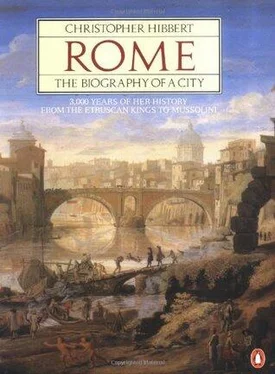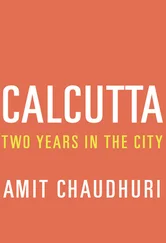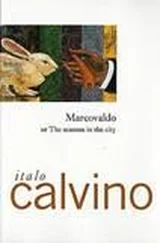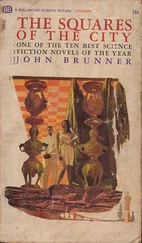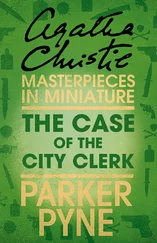Montesquieu, Charles-Louis; 1689–1755), 204, 211–12
Montezemolo, Giuseppe, 301
monuments: Christian, 68–9, 70–1, 73; conversion for Christian uses, 76; disintegration, 78; Carolingian renaissance, 81; deplorable condition by 1300, 105; domestic, 53–4; Bramante examines, 138; nineteenth century, 280-3; protected under Eugenius IV, 115; Pius II protects, 122; Renaissance, 155–6; demolition for entry of Charles V, 165; Queen Christina, 199; Stuarts’, 270, twentieth century, 307; Victor Emmanuel II, 280, 368
Moore, Dr John (1729–1802), 216
Moravia Alberto (b. 1907), 301
Morelli, Cosimo (1732–1812), 364
Morison, Colin, 217
Moro, Aldo (1916–78), 308
Murat, Joachim, King of Naples (1767–1815), 242, 243
Museo Barracco, 352
Museo Capitolino, see Palazzo Nuovo
Museo Chiaramonti, 355
Museo delle Terme, 36, 320
Museum of Rome, see Palazzo Braschi
Museums of the Vatican, see Vatican
Mussolini, Benito (1883–1945), 286, 303; arrest, 297–8; Dictator, 288–90; fall of Fascism, 299; at Grand Council meeting, 295; and Hitler, 293; March on Rome, 287; plans for development of Rome, 290; Prime Minister, 287; in Second World War, 195
Musuros, Markos ( c . 1470–1517), 151
Mylne, Robert (1734–1811), 222
Namatianus, Rutilius Claudius ( fl . 412–17), 70
Nanni di Baccio Bigio ( fl . 16th cent.), 171
Naples, Ladislas, King of (1377–1414), 112
Napoleon I, Emperor: annexes Papal States, 238; coronation, 237; depredations on Rome, 231–2; occupation of Rome, 237; and the Pope, 231; Napoleonic Civil Code, 242
Narses ( c .480–574), 74
Nazarenes, 270, 367
Nero, Emperor (37–68), 38, 39–41, 43–4; Christian persecution, 66–7; fire of 64 A.D., 40–41, 66; building works, 329
Nerva, Emperor ( c . 30–98), 52
Nicholas IV, Pope (Girolamo Masci, r. 1288–92), 95
Nicholas V, Pope (r. 1447–55), 112; appearance and personality, 113; building under, 115, 118; canonization of St Bernardine, 116; encourages the arts, 118; Universal Jubilee, 116; Vatican Library, 118, 344
Nobilior, Marcus Fulvius ( fl . 195–179 B.C.), 318
noble families ( see also Colonna and Orsini): Annibaldi, 90, 94, 97, 101–2; Barberini, 277; Boncompagni, 277, 278; Borghese, 277; Caetani, 90, 104, 113, 277, 278; Conti, 97, 102; Corsi, 88, 90; Crescenzi, 85–6, 89; Doria, 278; Farnese, 277; Frangipani, 90, 93, 97, 104; Normanni, 90; Laterani, 68, 329; Massimo, 277; Papareschi, 90; Pierleoni, 88, 90; Ruspoli, 278; Savelli, 90, 97, 101–2, 123; Tebaldi, 90; Torlonia, 277; Tuscolani, 86, 90
nobles: citizens' revolts against, 90, 101, 102, 106; Cola and, 99, 101, 103, 104; and new republic, 101–2; petty tyrants, 105–6
Numa Pompilius, King of Rome (trad., 71 5–673 B.C.), 5
Nugent, Sir Thomas ( c . 1700–1772), 224
obelisks: Paul VI erects, 230; Piazza della Minerva, 361; Piazza del Popolo, 355; Piazzo S. Giovanni in Laterano, 356; Piazza del Quirinale, 213, 365; Piazza di S. Maria Maggiore, 203, Piazza di Montecitorio, 365; Rameses II, 175–8, 342, 355; SS. Trinità dei Monti, 365; Villa Mattei, 94, 342
Odoacer, King of Italy (r. 476–93), 73
O'Flaherty, Hugh, 301
omens: attitude of ancient Romans to, 11–12; Romans respect, 209; Romulus and Remus, 3; Tarquin the Proud, 7
Orange, Philip, Prince of (1502–30), 157, 161
Orsini, Berthold, 106, 107
Orsini, Clarice, 147
Orsini, Giovanni Gaetano (Pope Nicholas III from 1227), 95
Orsini family: Calixtus III, 118; Cola di Rienzo and, 103, 104; and Colonna, 97; obliged to do homage, 101–2; power of, 90; revolt of 1351, 106; and Riario, 128; Sacro Possesso , 147
Orti, Farnesiani, 38, 321
Osborne, Sir D'Arcy, later 12th Duke of Leeds (1884–1964), 302
Ospizio di San Michele, 362
Otho, Emperor (32–69), 44
Otto I, the Great, Emperor (912–73), 83, 84, 85
Otto II, Emperor (955–83), 85
Otto III, Emperor (980–1002), 87
Oudinot, Nicolas-Charles (1767–1847), 260, 262, 269, 350
Ovid (43 B.C. – A.D. 17), 34, 49, 56
Pacca, Bartolomeo ( 1756–1844), 238
Palastrina, Giovanni Pierluigi da (1525–94), 172
Palatine hill: Belvedere Terrace, 62; Boswell climbs, 217; building programme under Augustus, 36; buildings, 36, 38, 41, 42, 88, 154–5; in eighteenth century, 221; fire on, 40–1; height, 315; House of Romulus, 8; location, 3; restoration work on, 74; Romulus and Remus, 3, 4; ruins, 78
Palatium Sessorianum, 68
Palazetto Venezia, 345
Palazetto Zuccari, 222, 363
Palazzo della Cancelleria, 71, 345; Bernini restores, 197; Giulio de' Medici, 152; Rossi at, 249; Sixtus IV and, 128; Winckelmann, 221
Palazzo Farnese, 351; Alexander Farnese and, 167; Carracci, 179; della Porta, 169; Queen Christina, 193; Salon d’ Hercule, 62
Palazzo Venezia, 345; demonstrators burst into, 299; Fascist Grand Council, 295; fifteenth-century windows, 125; Mussolini in, 288, 290, 291; Sala del Mappamondo, 289, 290; Sala del Pappa gello, 295
palazzi: Palazzo Albani, 221; Aldobrandini-Chigi, 361; Altempts, 347; Aste-Buonaparte, 366; Barberini, 190, 357; Borghese, 181, 204, 217, 356; Braschi, 229, 279, 300, 364; Caetani, 367; della Cancelleria ( see under separate entry ); Capranica, 351; Castelli, 155; Cenci-Maccarani-di Brazzà, 156, 351; Chigi, 288, 369; Chigi-Odescalchi, 197, 361; Cicciaporci, 156, 351; Colonna, 252; dei Conservatori, 169, 341, 352; Corsini, 232, 347; Doria, 189, 237, 238, 357; del Drago, 221, 363; Falconieri, 242, 366; Farnese ( see under separate entry ); Fiano, 359; dei Flavi, 322; Giraud-Torlonia, 136, 156, 181, 347; di Giustizia, 280, 368: Lante ai Caprettari, 156, 351; Lateran ( see under separate entry ); Madama, 280, 368; Massimo alle Colonne, 156, 351; Mattei di Giove, 342; di Montecitorio, 197, 240, 279, 361; Muti-Papazzurri, 219, 363; Niccolini-Amici, 348; Nuovo, 128, 169, 352; Orsini, 300, 320; Pallavicini-Rospigliosi, 181, 356; Pamphilj, 190–91, 358; dei Penitenzieri, 350– 1; Quirinal ( see under separate entry ); Riario, 130, 195, 347; Righetti, 318; Ruspoli, 266; dei SS. Apostoli, 159, 351; S. Marco, 125, 126, 134–5; Sallust ( see under separate entry ); del Senatore, 94, 169, 342, 352; Sforza-Cesarini, 133, 347; Soderini, 155; Spada, 172, 353; Torlonia, 195; del Viminale, 288, 369; Wedekind, 300, 370
Pamphilj, Camillo, 191
Pamphilj, Filippo Doria, Prince, 305
Pannini, Gianpaolo (1692–1765), 343
Pantheon, 324; Constans II plunders, 78; converted for Christian use, 76; Emperor Hadrian and, 59; Eugenius IV clears, 115; gold revetment stripped, 189; Queen Christina, 198
papacy: Charles of Anjou and, 95; Charles V and, 153; in danger at Avignon, 108; demand for abdication of temporal power, 90; disturbances and corruption, 84–6, 89; election of 1378, 110–11; and Emperor, 83, 91, 94; Eugenius II and, 90; financial responsibility, 122; influence and authority, 92; influence of Gregory I on, 75, 78; Julius II and temporal power of, 140–41; Lateran Pact, 290; Napoleon and, 231, 237; politics, 72, 126, 227; Republic and, 90–91; and return to Rome, 99, 108; Rome and, 94–5; rich Roman families and, 83; Second Vatican Council, 306; in Second World War, 302; Syllabus of Errors (1864), 273; Vatican Council (1869), 273; wealth, 141
Читать дальше
